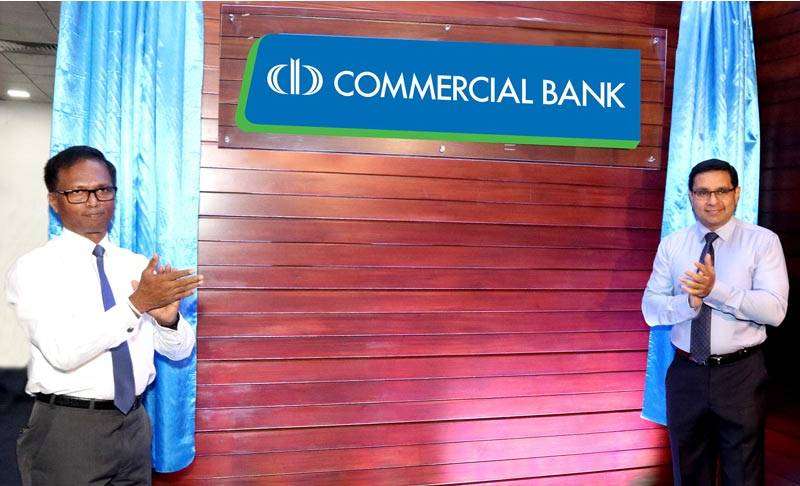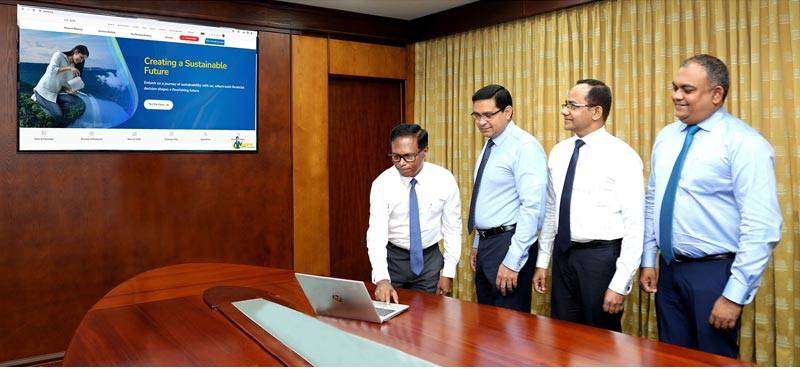Monday Apr 07, 2025
Monday Apr 07, 2025
Tuesday, 2 January 2024 01:42 - - {{hitsCtrl.values.hits}}

(Above) Commercial Bank Chairman Prof. Ananda Jayawardane and Managing Director/CEO Sanath Manatunge at the unveiling of the Bank’s new logo and (below) joined by Commercial Bank Chief Operating Officer S. Prabagar and Retail Banking and Marketing Deputy General Manager Hasrath Munasinghe at the launch of the Bank’s website with the new logo

The Commercial Bank of Ceylon has begun 2024 by underlining its commitment to sustainability – symbolically as well as literally.
The instantly-recognisable Commercial Bank logo in blue will hereafter also feature a green element, representing the Bank’s multifaceted commitment to sustainability, encompassing diversity, inclusivity, good governance, transparency, social equity, accountability and eco-friendly banking solutions, the Bank said.
“Our commitment to sustainability isn’t just a buzzword, it’s ingrained in our DNA, influencing our decisions, actions and the services we offer,” Commercial Bank Managing Director/CEO Sanath Manatunge commented. “We are a sustainable bank in everything we do, and the first organisation in Sri Lanka to proclaim that commitment in its corporate identity, and we want all our stakeholders, from employees, customers, shareholders and business partners, to see that at first glance.”
“The new logo reflects our dedication to total sustainability in all spheres of our operations and our practical commitment to the way we do business; from paperless transactions, responsible compliance practices, and energy-efficient operations,” Manatunge added.
The Bank follows a meticulously-crafted sustainability strategy and blueprint as a guiding principle for its sustainability activities. The strategy is based on three key pillars – sustainable banking, responsible organisation and community impact. There are nine core areas under these pillars – responsible financing, financial inclusion, sustainable products and services, green and safe workplace, workplace culture, social enterprise, social engagement, and environmental engagement.
The Bank said all these core areas align under seven selected Sustainable Development Goals (SDGs) set by United Nations, namely, quality education, gender equality, affordable and clean energy, decent work and economic growth, industry, innovation and infrastructure, responsible consumption and production and partnership for the goals.
In line with its sustainability goals, Commercial Bank has established a high level Sustainability Committee, which is responsible for sustainability strategy formulation and top-level decision making. The Bank’s Sustainability Working Committee with representation from all key business verticals is tasked with execution of the strategies adopted. To maximise staff engagement and awareness the Bank has introduced an awards programme for the Best Sustainable Branch and Department. Additionally, a Sustainability Group comprising of volunteers from various business units has been formed to engage employees in creating a sustainability culture within the organisation.
The Bank has also entered into collaborations with the IFC, the Asian Development Bank (ADB), the Global Green Growth Institute (GGGI) and the Green Building Council of Sri Lanka (GBCSL) to develop sustainable financing products that support eco-friendly manufacture, green operations and sustainable construction.
In the realm of environmental sustainability, the Bank has launched a tree-planting programwith the goal of planting 100,000 trees across the country, is supporting a turtle conservation project in Panama, has funded mangrove replanting, a reforestation project and a coral restoration initiative, is maintaining a stretch of coastline, has made significant headway in propagating paperless banking across multiple customer segments, and has installed solar power at more than 80 branches.
The Bank was a pioneer in commencing the assessment of environmental risks associated with lending projects with a comprehensive Social and Environment Management System (SEMS) framework. Similarly, the social and environmental impacts of its supply chains are reviewed via supplier selection and evaluation processes, and the impacts of aspects such as economic, environmental, social, human rights, society and product responsibility on the Bank’s operations and their materiality to the Bank as well as relevant stakeholders are assessed. Commercial Bank’s credit policy and lending guidelines clearly articulate the policies for the Bank to be a “Responsible Lender” by minimising transactions and activities which negatively impact the environment.
Discover Kapruka, the leading online shopping platform in Sri Lanka, where you can conveniently send Gifts and Flowers to your loved ones for any event including Valentine ’s Day. Explore a wide range of popular Shopping Categories on Kapruka, including Toys, Groceries, Electronics, Birthday Cakes, Fruits, Chocolates, Flower Bouquets, Clothing, Watches, Lingerie, Gift Sets and Jewellery. Also if you’re interested in selling with Kapruka, Partner Central by Kapruka is the best solution to start with. Moreover, through Kapruka Global Shop, you can also enjoy the convenience of purchasing products from renowned platforms like Amazon and eBay and have them delivered to Sri Lanka.
Discover Kapruka, the leading online shopping platform in Sri Lanka, where you can conveniently send Gifts and Flowers to your loved ones for any event including Valentine ’s Day. Explore a wide range of popular Shopping Categories on Kapruka, including Toys, Groceries, Electronics, Birthday Cakes, Fruits, Chocolates, Flower Bouquets, Clothing, Watches, Lingerie, Gift Sets and Jewellery. Also if you’re interested in selling with Kapruka, Partner Central by Kapruka is the best solution to start with. Moreover, through Kapruka Global Shop, you can also enjoy the convenience of purchasing products from renowned platforms like Amazon and eBay and have them delivered to Sri Lanka.